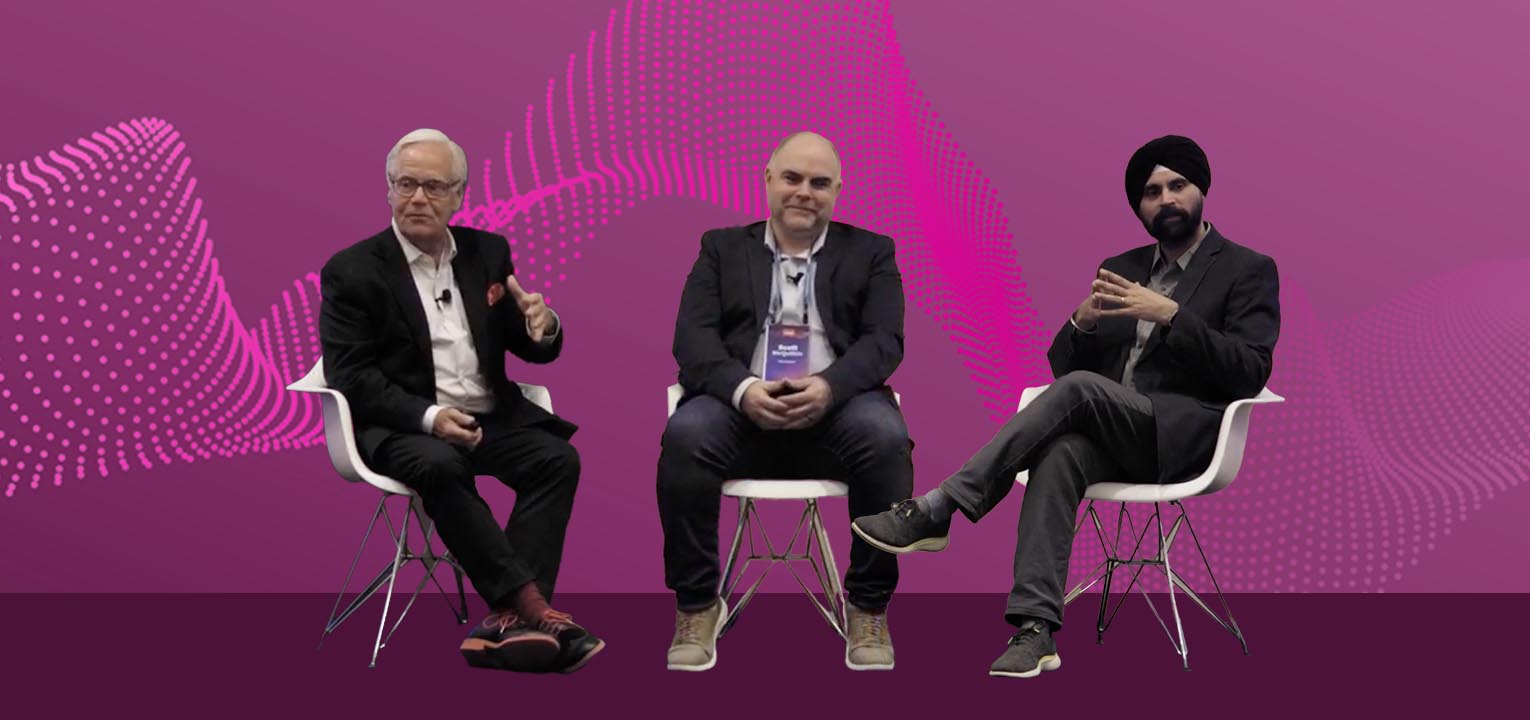December 16, 2021
Top 22 Digital Banking Trends for 2022 (Part 1): Driving Business Impact While Fulfilling the Social Contract

Banks managed to avoid the worst-case scenarios of the COVID-19 economic crisis, but that does not mean that all banks have a bright future. Many banks are underperforming in return on equity, and are being devalued by stock markets; according to McKinsey’s Global Banking Annual Review:
- Banks are trading at about 1.0 times their book value, compared to 3.0 times book value for all other industries.
- Financial services companies gained $1.9 trillion in market cap during the pandemic, but 65 out of 599 financial institutions accrued all the gains.
- Specialized financial services providers have average price-to-earnings ratios (P/E) of 20-30x. Banks have an average price-to-earnings ratio (P/E) of 15x, which is more like a typical utility.
The message is clear: banks are facing big challenges and are ripe for continued disruption by digital technology. The next four years are going to be a time of accelerating divergence between the leading banks who embrace digital transformation and the laggards who are left behind.
Banks need to future-proof themselves by adopting new business models, by increasing their pace and scale of innovation, and by reimagining what a bank should be. They need to adopt the best practices from challenger banks and fintechs, to create digital-first experiences that are embedded into their customers’ daily lives. And they need to act now, before it’s too late.
McKinsey found that in a future-proof business model for banks, the customer – not the product – will become the focus. Bank products need to become digital experiences that go beyond banking, that meet customer needs and are embedded into the customer’s daily life. Part of this process includes personalized analytical insights, which drive customer engagement and customer advocacy, and help the bank learn more about customer behavior and needs. Canadian bank RBC, a Personetics partner bank, is a prominent example of this trend. RBC’s AI-powered financial assistant NOMI app provides customers with cash flow forecasts and deep learning from customer transaction data.
The future of digital banking is not just about investing in new technology, it’s about evolving banks’ operations, business models, and company cultures to create a more customer-centric experience. The time is now for banks to embrace the new opportunities of digital banking while putting the customer at the center of their new business models – or risk falling behind into a downward spiral of lower valuations, customer attrition, and financial underperformance.
Let’s take a closer look at some of the top digital banking trends for 2022, and how they can drive business impact for your bank.
1. Don’t Get Complacent: Digital Banks Will Poach Your Customers
According to Galileo’s 2021 State of Consumer Banking and Money survey, 62% of U.S. consumers say that they are somewhat or highly likely to switch to a digital-only bank. This is especially true for the younger generations: 77% of Millennials and 72% of Gen Z consumers said they were likely to switch to digital, compared to 55% of Gen X and only 27% of Boomers.
Digital banking customers also have a higher level of customer satisfaction:
- 65% of consumers surveyed currently use a traditional bank as their primary provider, and only 66% of these customers are satisfied.
- Among customers who use digital-only banks (21%) and stand-alone digital accounts (7%) as their primary provider, 79% and 81% are satisfied.
For more on this, see the recent guest blog article from our partner Ron Shevlin at Cornerstone Advisors: “Banks Have Digital Engagement All Wrong. It’s Time for a New Model.”
2. Continued Expansion of Open Banking and Open Finance
Open banking and open finance are at the center of the biggest shifts in financial services today, and while this process will take years, 2022 will see continued momentum in this direction. According to Forrester, “2022 will see a growing number of banks experimenting and evolving their business models toward a more open, collaborative platform approach.”
Look for more banks, fintechs, and non-bank companies in 2022 to introduce innovative new financial products and offer more personalized financial advice with capabilities unlocked by open finance. Open finance will help banks add more value for their customers by integrating data from external accounts and third-party partners, creating a more holistic view of their customers’ finances.
For more of our latest insights on open banking, read our article: “From Transactions to Trusted Advisor: Why Open Banking 2.0 is a Game-Changer for Financial Services.”
3. Banking-as-a-Service (BaaS) and Embedded Finance
Consumers are becoming more receptive to the idea of using non-bank companies and social apps for banking-as-a-service (BaaS) and embedded finance, such as making payments, sending money to friends, or managing money. Galileo’s research found that many consumers are willing to use banking services offered by non-bank companies, such as streaming providers or Internet service providers. Consumers were especially interested in using non-banks to make purchases or get rewards and discounts.
Banking-as-a-service (BaaS) is a chance for banks to partner with non-financial companies to provide a suite of capabilities as a service, whether it’s processing payments or providing credit. The boundaries between banks and non-banks will continue to blur. Banks should use embedded finance as an opportunity to stay involved in their customers’ financial lives, no matter where and how those customers access banking services.
4. Growth of ESG Banking Products and “Green Banking”
Banks are facing stronger demands from consumers and from regulators to be part of the solution to fight climate change, do business according to environmental, social, and governance (ESG) principles, and provide eco-friendly “green banking” products and services. According to Forrester, top ESG product launches in 2022 will include “green loans and mortgages, and checking accounts with sustainability and carbon-tracking features.”
One of the biggest trends in green banking right now is carbon footprint tracking. Bank of the West was one of the first banks to launch a carbon tracking tool, as part of its 1% for the Planet checking account, which shows the carbon impact of the customer’s debit purchases. Challenger bank Aspiration also offers carbon footprint tracking with its Zero carbon credit card.
Consumers are starting to demand more detailed insights about the carbon emissions and climate impact of their everyday purchases. According to a Carbon Trust survey, 67% of international consumers support carbon labeling, and 64% would think more positively about brands that can show a reduction in their products’ carbon footprints.
In 2022, digital banking features will become more prevalent as a way for banks to help customers make better-informed choices about how their spending affects their carbon footprints.
Banks have new tools available now to show leadership on climate change by helping their customers to see their personal carbon footprint based on consumer transaction data. When customers can see the climate impact of their everyday spending choices, they can be empowered to make greener choices.
Personetics believes that banks can use carbon footprint tracking to go further in leading the transition to a sustainable economy, and driving business impact for their financial institutions. Our Carbon Footprint Tracking solutions help banks not only show their customers their carbon emissions data, but proactively reach out to those customers with relevant financial advice and recommended ESG products. Green banking is not just about showing customers their carbon footprint, it’s about connecting customers with automated savings programs to achieve financial wellness.
For example, banks can use Personetics’ Carbon Footprint Tracking tools to show their customers how to save for specific financial goals related to sustainability, such as “how to save for solar panels on your house” or “how to save for an electric vehicle.”
To learn more, read our latest thought leadership on how carbon footprinting can create a green banking future. Or sign up to get our carbon footprint tracking datasheet to see how this new capability can drive value for your bank and improve financial wellness for your customers.
5. Strategic Emphasis on Banking UX Design
Traditionally, many banks considered user experience (UX) design to be more of a marketing feature than a core part of the product offering. But in recent years with the rise of fintechs with their cleverly designed, user-friendly mobile apps, banks have rediscovered the strategic value of UX design and the quality of their user interfaces.
In 2022, look for more banks to have focused, strategic conversations about banking UX design. A few top banking UX design trends include:
- UX design reflects the brand promise: Banks’ UX design isn’t just about logos and color schemes. The best UX design embodies the bank’s brand and personality with a unique voice and style of customer engagement while supporting the values of security, stability and trustworthiness.
- Vision for a complete ecosystem: All bank channels, digital or physical, should convey the same coherent brand message and visual elements. Engaging with a bank’s brand should deliver a coherent interactive experience, whether it’s at an ATM or via the bank’s mobile app.
- More emotional, human-centric banking: Banking UX design is not just about transactions and signup screens, it’s about creating an emotional engagement with the customer. Understanding the customer’s emotions and anticipating their needs can help UX design be more intuitive, elegant, and delightful.
Want to learn more about UX design for banking? Check out our recent blog post on how banks can make user experience their next competitive advantage.
6. Taking Financial Wellness to the Next Level
Many middle-to-lower-income bank customers struggle to pay their bills, save money, and get access to good financial advice. Recent surveys have found that 44% of U.S. consumers are living paycheck-to-paycheck, and yet only 25% of consumers say that they would ask a bank or credit union for financial education.
Employers also are showing a stronger interest in providing financial wellness programs for their employees. The Bank of America 2021 Workplace Benefits Report found that 95% of employers feel a sense of responsibility for their employees’ financial wellness, 46% of employers are offering financial wellness programs (up from 40% in 2020), and 47% are providing their employees with access to financial advisors (up from 40% in 2020).
As financial wellness and financial education become higher priorities for employers and a larger topic of public conversation, banks have an opportunity to use digital tools to deliver comprehensive financial wellness support to their customers.
One prominent example is Bank of America’s Life Plan®, a digital financial wellness program that helps customers set and make progress toward specific financial goals. As of October 2021, one year since the program was launched, more than 5 million customers have signed up for Life Plan, and those customers’ account balances have increased by $34 billion. Life Plan customers have also set up more than 1 million follow-up appointments with Bank of America financial professionals, showing how digital tools for financial wellness can help drive additional personal interaction with customers.
Banks are using digital tools focused on financial wellness to add value to their customers and establish a reputation for Corporate Social Responsibility (CSR). In December 2021, 28 global banks signed the Commitment to Financial Health and Inclusion as part of the United Nations Environment Programme’s Principles for Responsible Banking. The Commitment to Financial Health and Inclusion is a framework for banks to set specific targets for promoting universal financial inclusion and financial health, along with fighting climate change, nature loss and pollution.
One of the areas covered by the Commitment is data analytics, including “improved data capture (including disaggregated data) to run models for behavior anticipation and for avoiding risk of discrimination or bias in service offerings, alternative credit scoring models for financially excluded groups.”
At Personetics, we believe that fintech and financial services are a force for positive change in the world. By signing the Commitment to Financial Health and Inclusion, some of the world’s leading banks are making a strong statement that they are going to take additional action to help more of the world’s people benefit from the protections and advantages of the financial system, while using the power of finance to confront the planet’s biggest challenges.
For more on how banks can join the fight against climate change while driving business impact, read our blog on “Why Banks and B2C Companies are Embracing Carbon Footprinting.”
7. Digital Channels Boost Branch Productivity
Branch closings and branch consolidations have been an ongoing trend in banking for the past several years, but brick-and-mortar bank branches still have a valuable role to play in delivering financial services, even among digital-first financial institutions.
People still want to use bank branches. Recent surveys found that 79% of global consumers used a physical bank branch in the last year, and 35% use a bank branch at least once a month. In the next year, U.S. consumers say that they plan to visit their branch at least 3 times per month.
What do people want from their bank branches? Financial advice and education. According to the Financial Brand, “Gen Z consumers say they would be almost twice as likely (46%) to visit a branch if they could drop-in for financial advice and 43% more likely if their banking provider offered a financial experience center. Another 40% more said they would be more likely to use branches if there were financial education sessions there.”
This shows that there is an opportunity for banks to combine digital banking channels with personal interactions at the branch. Just as Bank of America had success by engaging customers via its Life Plan digital experience, and then drove more follow-up conversations with financial professionals, digital banking can often be a touchpoint that generates more foot traffic to the bank.
Banks don’t have to close all their bank branches in a digital world. Instead, use digital tools to boost productivity of branches and give people new value-adding reasons to visit the branch, with a focus on financial education and wellness.
8. Digital Banking is a Positive Force for Financial Inclusion
As of 2017, according to the World Bank’s Global Findex Database, approximately 1.7 billion adults worldwide were unbanked. Digital banking tools have helped millions of people move away from cash-based transactions and get access to formal financial services, including payments, credit, savings, insurance, and securities, via mobile phones or other consumer technology. A recent study cited by the U.N. Environment Programme found that “improving the availability and accessibility of affordable financial products and services could increase GDP in developing economies by up to 14% and in frontier markets by 30%.”
Digital banking is opening new opportunities for financial inclusion for women worldwide, especially as the pandemic accelerated the use of digital banking tools. Even before the pandemic, approximately 140 million women opened a bank account for the first time for the purpose of receiving government payments.
In 2022, digital banking will continue to be a strong force for greater digital financial inclusion and protecting people from financial vulnerability. In many lower-income countries, people send and receive money via their mobile phones. Digital banking technology can be part of the solution to help some of the world’s poorest people stay resilient during financial shocks.
People often need financial education along with helpful digital banking products. During 2020, the BBVA Microfinance Foundation provided financial education training to 400,000 people in five countries, with a focus on helping women entrepreneurs and small farmers. The goal: help financially vulnerable people maintain a minimum living standard and avoid falling back into poverty.
Digital banking technology has been especially important during the pandemic, when 186 countries sent $1.25 trillion of relief payments directly to their citizens. In 2020, the African nation of Togo, where the average per capita income is less than $2 per day, set up an all-digital system called “Novissi” (“solidarity” in the local language) to send monthly Covid relief cash payments to approximately 25% of the adult population, via “mobile money” on mobile phones. The system took only 2 weeks to set up and was widely seen as a success. In the future, look for more governments and NGOs to use this model of digital tools for direct cash transfers to help people in need during times of natural disaster.
9. Providing Access to Inclusive Credit
By building upon the momentum of open banking, traditional banks, digital banks, and non-financial institutions can identify new inclusive credit offerings and assess creditworthiness for customers who are underrepresented by conventional credit reporting.
In the U.S. market, 4.4 million new businesses were started during 2020, representing a 24% year-over-year increase. Many of these new businesses might not have any commercial credit history, which makes it hard for them to access small business loans. Lenders are becoming more flexible at using nontraditional data sources, such as social media check-ins, customer reviews, and online profiles, to help evaluate credit risk when lending to small businesses.
In the U.S. market, credit unions have a unique mission that is related to inclusive finance; credit unions provide access to credit for communities who might have been underserved by traditional banks. Credit unions also have a strong focus on improving their members’ financial wellness. We believe that credit unions have a bright future with digital banking and a new era of more agile, personalized services. Learn more about how credit unions can avoid the digital arms race and focus on their local member relationships.
10. Teaching Digital Skills for Financial Success
Communities who have been underserved by the traditional financial system will often benefit from financial education, and this is also true of learning new digital technologies. Mastercard’s Center for Inclusive Growth has provided an online digitization program to help people improve their financial wellness. 64% of participants said the program helped improve their financial health, 50% felt more secure, and 50% felt more at ease with managing their money online.
Look for more digital banking solutions in 2022 that have an emphasis on financial education, whether it’s for first-time users or for longtime bank customers who just want to get more out of their money.
11. Addressing Racial Inequality
In the U.S. market, Black and other racial minority communities have traditionally faced systemic discrimination and barriers to banking, credit, and wealth-building opportunities. Digital banking can potentially be part of the solution to the racial wealth gap.
A few prominent fintech startups are leading the way:
- Greenwood is a Black-and-Latino-owned digital banking platform with a mission to further the financial empowerment of Black and Latino communities who have been traditionally underserved and excluded by the financial system. The company has more than 500,000 customers signed up on its waiting list and is planning to be available to the general public in early 2022.
- 1% for the Planet checking account is an “equitable bank” fintech startup founded by a Black woman, which offers a neobank, debit card, money saving tools, and financial education support. The platform lets customers set up Money Goal Buckets to save for financial goals, and track transactions and spending categories.
As customers demand banks to be more socially responsible, financial inclusion is a strategic imperative for digital transformation. Diversity, Equity & Inclusion (DEI) can also be part of the conversation for banks with their ESG initiatives, and digital channels can be an essential way to provide inclusive financial products and services for traditionally underserved communities.
In 2022, banks are going to adopt innovative digital banking technology while finding new ways to support the traditional social contract between financial institutions and their customers. Banks are under pressure to adapt their business models, embrace digital transformation, and compete with challenger banks and fintechs. But one common element of all of these trends, regardless of the technology aspects, is that they all involve putting people first. Putting people at the center of the banking experience is what digital banking is ultimately about: connecting people with the right products and advice, extending credit to people who need it, developing a digital user experience that supports and delights the customer, and creating a financial system that is more inclusive, resilient, adaptable, and capable of confronting humanity’s biggest challenges.
Coming Soon: Part 2 of our two-part series on top 22 trends for digital banking in 2022.
Ready to discuss your financial institution’s goals for 2022? Talk to Personetics today.
Want to explore how your bank can harness the power of AI to engage and serve customers? Request a demo now
Latest Posts

The AI Implementation Reality Check

Why Asia Pacific Pacific Banks Must Lean into Cognitive Banking: A Conversation with Dr. Dennis Khoo

Explore our Spring Release Highlights – From Integrated Marketing Offers, to Custom Trackers, and AI Innovation

Dorel Blitz
VP Strategy & Business Development
Dorel Blitz brings over 13 years of experience in global strategy and business development in the financial services industry. Dorel joins Personetics from KPMG, where he headed the Fintech sector at KPMG Israel and a member of the global Fintech practice. In this role, Dorel was instrumental in establishing KPMG’s collaborative relationships with global financial institutions and leading Fintech companies including Personetics. He also acted as a subject matter expert and led advisory projects involving digital transformation strategies with financial services organizations. Prior to joining KPMG, Dorel led the Innovation & Fintech practice at Bank Leumi, and earlier in his career, he headed the banking & finance division at global research firm Adkit.









